LPC-4
Douglas Cram, Nicholas Ashcroft, and Kert Young
College of Agricultural, Consumer and Environmental Sciences, New Mexico State University
Authors: Respectively, Extension Forest and Fire Specialist, Range Improvement Task Force; Policy Analyst, Linebery Policy Center for Natural Resource Management; and former Extension Brush and Weed Specialist, Range Improvement Task Force, New Mexico State University. (Print Friendly PDF)
Introduction
In September 2007, the New Mexico State Forestry Division (hereafter Forestry Division) designated pinyon (Pinus spp.) and juniper (Juniperus spp.) trees as “commercial forest species” subject to regulation under the New Mexico Administrative Code (NMAC) section 19.20.4.2 Prior to this designation, only traditional sawtimber species such as ponderosa pine (P. ponderosa) and Douglas-fir (Pseudotsuga menziesii) were designated as commercial timber species and subject to state harvest regulations. In a letter to the NM State Legislature in 2008, the Forestry Division cited the following reason for the revision to the Commercial Timber Harvesting Requirements (i.e., NMAC 19.20.4):
“Since 2002, the interest in using woody biomass, including trees such as pinyon and juniper, for electricity production, cellulosic ethanol fuel and for heating in New Mexico has increased. In addition, pinyon and juniper trees are being commercially harvested on a large scale for firewood and to a smaller scale for wood composite manufacturing. Due to the commercial nature of these existing and planned activities, the Division added these species to the commercial timber harvesting requirements. The requirements assure that the harvests are silviculturally sound and that owners and other responsible persons or entities comply with harvesting methods and slash treatment to reduce fire threat and insect and disease infestations. It is also important for the Division to compel harvest methods and erosion management standards that ensure harvest activities do not negatively affect water quality.”
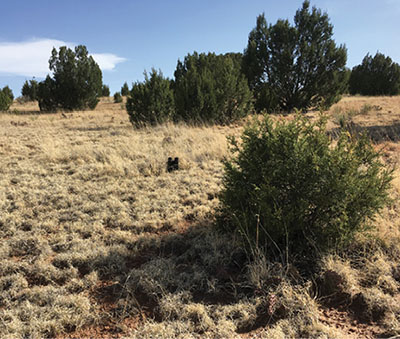
The Forestry Division further stated that prior to adopting the revised regulations, they reviewed the amendments for adverse effects to small businesses and found little potential for significant impacts.
The addition of these tree species increased the regulatory scope of the Forestry Division by 5.6 million acres of private pinyon-juniper woodlands (Figure 1). Considering the substantial increase in regulatory scope on private land, NM stakeholders questioned the potential economic impacts to private landowners, forest-product enterprises, and entrepreneurs seeking to advance new, value-added ventures. In 2008, the NM Legislature as well as small businesses and agricultural groups from across the state called for a cost-benefit assessment of the pinyon-juniper regulations and their effects on private landowners and entrepreneurial interests. Two separate bills cleared their respective committees, but died thereafter—i.e., “Action Postponed Indefinitely” (House Bill 565 and Senate Bill 476, 48th Legislature, State of New Mexico, Second Session 2008). The concept the NM Legislature was preparing to explore was how potential costs to private landowners compared with benefits. Because no assessment was conducted at the time of the regulatory change, we took the opportunity to revisit the regulation 12 years after its inception to explore general outcomes. Evaluating ecological outcomes was beyond the scope of this paper; we did not have empirical data to quantify on-the-ground conditions.

Figure 1. Pinyon-juniper distribution on private and state trust lands in New Mexico based on USGS Gap Analysis landcover data from 2004. Dark-green shading represents pinyon-juniper cover on private land (5.6 million acres). Light-tan shading is non-private land, and white is private land without pinyon-juniper cover.
Objectives and Approach
Our objectives of the review were educational in nature, with the intent to document the 2007 policy change and broadly discuss outcomes to date (i.e., 2019). We conducted a literature review on state government regulations of forestry practices and how they affect private forestlands. We reviewed the regulation (NMAC 19.20.4) for potential issues affecting private landowners. Finally, we talked to eight NM landowners (from six counties: Colfax, Grant, Guadalupe, Lincoln, Mora, and Torrance), three wood-product stakeholders (from three counties: Colfax, Grant, and Sandoval), and six NM Forestry Division personnel to understand regulatory outcomes. Individuals were contacted by telephone in 2019.
Pinyon-Juniper Woodlands in New Mexico
Pinyon-juniper woodlands are the largest forest cover type in NM, comprising 14.6 million acres (representing 65% of NM forests; USGS Gap Analysis Program–Land Cover Data). In contrast, the next largest forest cover types in NM are ponderosa pine at 5.2 million acres (23%) and mixed conifer at 1.5 million acres (7%). Pinyon-juniper forests occur on a wide range of topographic sites, such as mesas, plateaus, canyons, rocky outcrops, and from foothills to low mountains ranging in elevation between 4,500–8,000 feet (Dick-Peddie, 1993). Pinyon-juniper cover types occur where annual precipitation ranges between 10–20 inches (Dick-Peddie, 1993). Pinyon-juniper woodland soils are typically characterized as shallow, well-drained, low-fertility, and often susceptible to erosion due to the high proportion of bare soil (Evans, 1988). In the absence of recurring fire, woodlands have also expanded into deeper and more fertile soils.
In addition to pinyon, which is the most common pine species in NM (Dick-Peddie, 1993), other overstory woodland-pine species include border pinyon (P. discolor), Mexican pinyon (P. cembroides), one-leafed pinyon (P. monophylla), and a one-needle variety (P. edulis var. fallax). Common overstory juniper species in NM woodlands include alligator juniper (J. deppeana), one-seed juniper (J. monosperma), Rocky Mountain juniper (J. scopulorum), and Utah juniper (J. osteosperma) (Dick-Peddie, 1993). Understory vegetation is characterized by a wide range of shrubs, grasses, and forbs, depending on site conditions.
History of New Mexico Timber Harvest Regulations
Early in the 20th century, private landowners began expressing interest in sustainable forest management across the United States amid concerns of timber shortages and lack of knowledge about long-term timber management implications (Kilgore et al., 2007). It was during this time (1930s and 40s) that numerous state governments first began to draft and adopt “best management practices” (BMPs). New Mexico formally recognized the importance of natural resource management in upper watersheds and subsequently drafted a Best Management Practices statute in 1939. In 1970, the statute was replaced by the first forest practices regulation, titled Tree Harvesting and Forest Regeneration (NMAC 19.20.2). The objective was “to require appropriate forest resource management in order to assist in the prevention and suppression of forest fires, the control of forest pests and to maintain and enhance the economic benefits of forests and forest resources to New Mexico.” In 2002, NMAC 19.20.4, Commercial Timber Harvesting Requirements, was issued to replace NMAC 19.20.2. The requirements applied to “persons, partnerships, associations, corporations, and other entities engaged in harvest of commercial forest species on non-municipal or non-federal lands.” Revisions to NMAC 19.20.4 were made in June 2007, and three months later the definition of commercial forest species was expanded to include all pinyon-juniper tree species found in NM, including oak species (Quercus spp.) in tree form (Table 1).
|
Table 1. Pinyon and Juniper Species Added to the Commercial Forest Species List in NMAC 19.20.4, Section 7, Commercial Timber Harvesting Requirements on September 2007(oak [Quercus] species in tree form were also added to the list) |
|
|
Scientific namea |
Common name |
|
Juniperus coahuilensis |
Roseberry juniper |
|
J. deppeana |
Alligator juniper |
|
J. monosperma |
One-seed juniper |
|
J. osteosperma |
Utah juniper |
|
J. pinchottii |
Pinchot’s juniper |
|
J. scopulorum |
Rocky Mountain juniper |
|
Pinus cembroides var. cembroides |
Mexican pinyon pine |
|
P. cembroides var. bicolor |
Mexican pinyon pine |
|
P. edulis |
Pinyon pine |
|
P. monophylla |
Arizona single-leaf pinyon |
|
aPlant nomenclature follows Flora Neomexicana I: Annotated Checklist (Allred, 2012). |
|
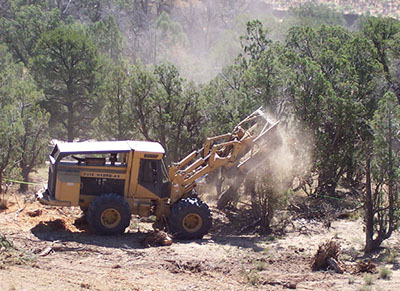
Economic Effects of Timber Regulations on Private Landowners
The ultimate goal for regulatory programs is process efficiency, clear guidelines, predictable results, and enhanced environmental quality that encourages economic activity (Ellefson et al., 1995). Additional publications suggesting criteria for regulatory design and their evaluation are as follows: Ellefson et al., 1995, 1997, 2001, 2007; Kilgore et al., 2007; Butler et al., 2016; and Cristan et al., 2016. Further, the Society of American Foresters published—originally in 1975 and updated through the years, including 2019—criteria for public regulation of private forests practices as follows: (1) have a knowledge-based and transparent design, (2) ensure that forests are managed sustainably but allow for flexibility, and (3) be achievable and consistent.
Across the nation, numerous studies have reported on how sawtimber policy and harvest regulations affect private forest landowners in terms of costs (Ellefson and Miles, 1985; Olsen et al., 1987; Henly et al., 1988; Haney and Cleaves, 1992; Henly, 1992; Lickwar et al., 1992; Ellefson et al., 1995; Aust et al., 1996; Johnson et al., 1997; Cubbage, 2004; Sun, 2006; Kilgore et al., 2007). However, in the case of pinyon-juniper regulations, there have been no studies conducted pertaining to landowner costs. This may be explained by the fact that no other states—outside of Utah—regulate the commercial harvest of pinyon-juniper species. Given the current limited scope of pinyon-juniper harvesting at the commercial scale in NM, potential insights from sawtimber studies may be constrained until a time when the pinyon-juniper market is growing as referenced by the Forestry Division in its 2008 communication with the NM Legislature.
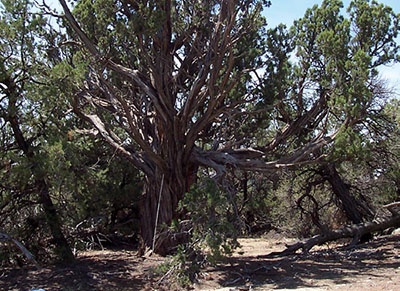
19.20.4 Regulatory Review—Challenges and Assistance for Private Landowners
There are potential direct and indirect costs for private landowners to obtain a pinyon-juniper harvest permit. Direct costs include time and expenditures to prepare the required forest harvest plan, or even hire a forestry consultant (NMAC 19.20.4.8, section D). For example, the following information is necessary for the permit: a current description of stand conditions including type of trees, insect and disease status, and stocking characteristics (i.e., trees per acre, basal area, or green tons per acre, as applicable), as well as an estimate of residual stocking conditions following harvest. Additional technical information required for the permit includes a detailed plan and description for erosion management, skid trails, roads, streamside management areas, slash treatments, fire precautions, and excessive slopes. However, the cost to the private landowner for putting together this information may be reduced or eliminated by requesting technical assistance from the NM Forestry Division. This option is promised in the New Mexico State Constitution, Statutory Chapter 68-2-25. Specifically, technical assistance may be requested for specific sites prior to and during harvesting activities.
Indirect costs fall under the category of opportunity costs. An opportunity cost is defined as the cost of pursuing one course of action measured in terms of the foregone return that could have been earned (or saved) on an alternative course of action that was not undertaken. For example, logistical challenges related to obtaining a permit include gathering data and preparing the permit for submission (NMAC 19.20.4.8, sections C and F), revising the permit in the event of permit denial (NMAC 19.20.4.8, section E), revising the permit following harvest inspection by the Forestry Division (NMAC 19.20.4.8, section G), coordinating with the Forestry Division for weather delays (NMAC 19.20.4.11) and on-site visits/inspections (NMAC 19.20.4.12, section B), and working within established submission, revision, and appeal timetables (NMAC 19.20.4.8, sections C and E, and NMAC 19.20.4.13, respectively), as well as on-the-ground practice and notification deadlines (NMAC 19.20.4.9 and NMAC 19.20.4.8, section I, respectively). The magnitude of the opportunity cost will depend on the time and money spent obtaining a permit as well as complying with specific rules and regulations during the harvest operation.
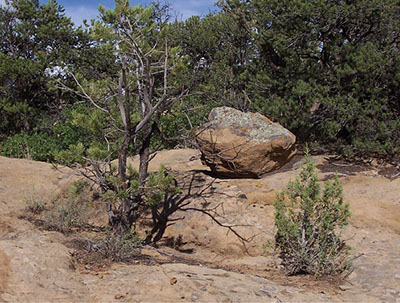
Outcomes: Feedback from Stakeholders (Landowners, Agency Personnel, and Forest Industry)
To date, only two pinyon-juniper permits have been issued by the Forestry Division since 2007. The first pinyon-juniper permit was issued in 2010 in Catron County. As it turns out, this first permit was significant in size and volume. Specifically, over the course of three years, the permit covered 4,000 acres and produced 512,000 cubic feet of roundwood material for commercial firewood sale. The second permit was issued in 2018 for 250 acres in Taos County, with pinyon-juniper firewood as the intended market product. The small number of permits over a 12-year period may be explained by the lack of a growing and demanding market for pinyon-juniper as a biomass/bioenergy fuelstock. In our conversations with forest industry personnel, none indicated that they were looking at or cutting pinyon-juniper species at a commercial scale, if at all, as it related to biomass/bioenergy markets.
Another impact-mitigating factor for landowners over the last 12 years may be the utilization of four different permit exemptions written into the policy in 2007—NMAC 19.20.4.8, section B, numbers 2, 7, 8, and 9. Specifically, B2 increased the threshold for requiring a permit to cut firewood from 25 to 75 acres. This increase in acreage—in any one contiguous location in a calendar year—represented a significant expansion for commercial firewood cutters. To date, this 75-acre threshold seems to have provided firewood cutters in NM the latitude to operate without the need for a permit. The second exemption, B7, stated that harvests for wildland-urban interface projects or hazardous fuel reduction projects, if conducted pursuant to a contract with the Forestry Division following forest-harvest practice standards (NMAC 19.20.4.9), do not require a permit. The third exemption, B8, stated that harvests conducted under a Forestry Division funded or administered landowner assistance program—such as the Environmental Quality Incentives Program (EQIP) administered by the Natural Resources Conservation Service—and in compliance with forest-harvest practices standards (NMAC 19.20.4.9) do not require a permit. The final exemption, B9, which specifically targeted landowners with pinyon-juniper rangelands, allowed for “rangeland or meadow restoration” at any scale without a permit, but only if goods are not exchanged for services rendered.
Although exemptions provide potential flexibility, individuals within the Forestry Division are integral to facilitating positive interactions with landowners. New Mexico District Foresters and their staff have a culture and history of providing beneficial forestry assistance to NM landowners and have not pursued punitive approaches allowed by regulations. This intentional approach has mitigated impacts to landowners related to pinyon-juniper regulations. However, a harvest permit can also benefit the landowner in situations where a contractor has not followed the contract. For example, if negative outcomes such as erosion or hazardous slash conditions occur because a contractor failed to follow contractual best management practices, the permit provides mitigating recourse for the landowner via the Forestry Division. In other words, the permit allows the Forestry Division to hold the contractor accountable to the benefit of the landowner. In absence of a permit, a civil lawsuit may be the next best option.
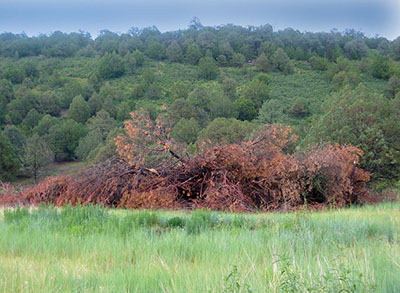
Summary
There are 5.6 million acres of pinyon-juniper woodlands in NM under private ownership. Given this geographical footprint and the associated economic and ecological values therein, it is reasonable to understand the interest in its management and conservation. However, it is also reasonable to question the cost-benefit outcomes for private landowners resulting from regulations. To address this concern, policy research and analysis have provided guidelines for establishing timber harvest regulations, including benchmark criteria as published by the Society of American Foresters (2019). However, other than this review, there are no published studies looking at pinyon-juniper regulatory impacts to states. To date, due to the lack of a growing biomass/bioenergy market for pinyon-juniper material, the commercial demand for these woodland species—outside of firewood cutting—has not evolved in NM. This is evidenced by the issuance of only two pinyon-juniper permits over a 12-year period. Regulatory exemptions for expanded firewood cutting and rangeland restoration projects have further mitigated potential impacts to private landowners and woodcutters. District forest offices across the state have also helped mitigate regulatory impacts by providing guidance and assistance to landowners looking to meet their management goals. Harvest permits may also benefit landowners seeking mitigation following contractor negligence.
Acknowledgments
We wish to thank the NM forest-products industry, NM landowners, and New Mexico State Forestry personnel for communicating and sharing their insights with us regarding pinyon-juniper regulations in NM. We also wish to thank Chris Jones (University of Arizona Cooperative Extension), Les Owen (Colorado Department of Agriculture), Tom Sidwell (New Mexico rancher), Mary Stuever (New Mexico State Forestry Division), and Marshal Wilson (New Mexico Department of Agriculture) for reviewing this manuscript and providing helpful comments. We further thank Les Owen for his GIS expertise in generating the data used in Figure 1. Martin Moore provided input on the first draft of this manuscript.
Literature Cited
Allred, K.W. 2012. Flora Neomexicana I: Annotated checklist, 2nd ed. Morrisville, NC: Lulu Press.
Aust, W.M., R.M. Shaffer, and J.A. Burger. 1996. Benefits and costs of forestry best management practices in Virginia. Southern Journal of Applied Forestry, 20, 23–29.
Cubbage, F.W. 2004. Costs of forestry best management practices in the south: A review. Water, Air, and Soil Pollution: Focus 4, 131–142.
Dick-Peddie, W. 1993. New Mexico vegetation. Albuquerque: University of New Mexico Press.
Ellefson, P.V., and P.D. Miles. 1985. Protecting water quality in the Midwest: Impact on timber harvesting costs. Journal of Forestry, 2, 57–61.
Ellefson, P.V., A.S. Cheng, and R.J. Moulton. 1995. Regulation of private forestry practices by state governments [Station Bulletin 605–1995]. Minnesota Agricultural Experiment Station, University of Minnesota.
Ellefson, P.V., A.S. Cheng, and R.J. Moulton. 1997. State forest practice regulatory programs: An approach to implementing ecosystem management on private forest lands in the United States. Environmental Management, 21, 421–432.
Ellefson, P.V., M.A. Kilgore, and M.J. Phillips. 2001. Monitoring compliance with BMPs: The experience of state forestry agencies. Journal of Forestry, 99, 11–17.
Ellefson, P.V., M.A. Kilgore, and J.E. Granskog. 2007. Government regulation of forestry practices on private forest land in the United States: An assessment of state government responsibilities and program performance. Forest Policy and Economics, 9, 620–632.
Evans, R.A. 1988. Management of pinyon-juniper woodlands [General Technical Report INT GTR-249]. U.S. Department of Agriculture, Forest Service, Intermountain Research Station.
Haney, Jr., H.L., and D.A. Cleaves. 1992, April. Potential cost of forestry regulation in the south. Forest Farmer, 8–11, 21.
Henly, R.K. 1992. Cost of small landowner timber harvesting plans. Sacramento: California Department of Forestry and Fire Protection, Strategic and Resource Planning Staff.
Henly, R.K., P.V. Ellefson, and R.J. Moulton. 1988. State regulations of private forest practices: What accomplishments at what cost? Western Wildlands, 13, 23–28.
Johnson, R.L., R.J. Alig, E. Moore, and R.J. Moulton. 1997. NIPF landowners’ view of regulation. Journal of Forestry, 95, 23–28.
Kilgore, M.A., J.L. Greene, M.G. Jacobson, T.J. Straka, and S.E. Daniels. 2007. The influence of financial incentive programs in promoting sustainable forestry on the nation’s family forests. Journal of Forestry, 105, 184–191.
Lickwar, P., H. Clifford, and F.W. Cubbage. 1992. Costs of protecting water quality during harvesting on private forestlands in the southeast. Southern Journal of Applied Forestry, 16, 13–20.
Olsen, E.D., D.S. Keough, and D.K. LaCourse. 1987. Economic impact of proposed Oregon forest practices rules on industrial forest lands in the Oregon Coast Range: A case study. Corvallis: Forest Research Laboratory, College of Forestry, Oregon State University.
Society of American Foresters. 2019. State policies regarding private forest practices. A position of the Society of American Foresters. Bethesda, MD. www.safnet.org.
Sun, C. 2006. Welfare effects of forestry best management practices in the United States. Canadian Journal of Forest Resources, 36, 1674–1683.
USGS National Gap Analysis Program. 2004. Provisional digital land cover map for the southwestern United States, version 1.0. RS/GIS Laboratory, College of Natural Resources, Utah State University.
2A complete listing of the regulation can be found by searching the internet for “NMAC 19.20.4.” (Back to Top)
For Further Reading
LPC-1: Economic Contribution of the Beef Cattle Industry to New Mexico
https://pubs.nmsu.edu/taskforce/lpc/LPC1/
LPC-3: Is There Enough Grass? Balancing Forage Supply and Demand
https://aces.nmsu.edu/pubs/taskforce/lpc/LPC3/welcome.html
G-102: Firewood Facts
https://pubs.nmsu.edu/_g/G102/

Douglas Cram is a College Assistant Professor at New Mexico State University. He earned his Ph.D. at New Mexico State University. His research and Extension programs focus on forestry and fire ecology in the Southwest.

Nicolas K. Ashcroft is the Natural Resource Policy Analyst, Sr., at the Linebery Policy Center for Natural Resource Management. He serves as the spokesperson for the Center and conducts objective, quantitative analysis of potential impacts of proposed policies, regulations, and laws on federal, state, and private land. He also works at developing a grassroots network throughout New Mexico and the 11 western states.

Kert Young is an Extension Rangeland Brush and Weed Specialist at NMSU. He has experience controlling invasive plants with mechanical, chemical, cultural, and other techniques. His Extension and research work helps the people of New Mexico understand how to manage invasive plants and repair damaged range and pasture lands, and benefits land condition, productivity, sustainability, and profitability for an improved quality of life for New Mexicans.
To find more resources for your business, home, or family, visit the College of Agricultural, Consumer and Environmental Sciences on the World Wide Web at pubs.nmsu.edu.
Contents of publications may be freely reproduced, with an appropriate citation, for educational purposes. All other rights reserved. For permission to use publications for other purposes, contact pubs@nmsu.edu or the authors listed on the publication.
New Mexico State University is an equal opportunity/affirmative action employer and educator. NMSU and the U.S. Department of Agriculture cooperating.
July 2021 Las Cruces, NM


